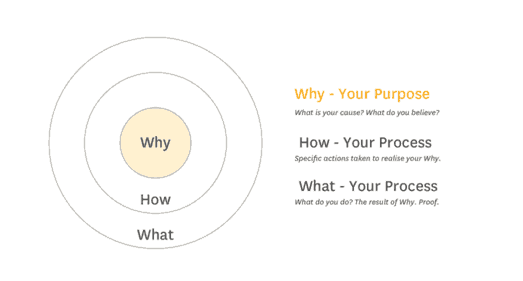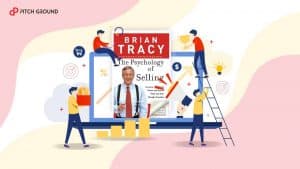“Start With Why,” a book that has influenced many professionals and entrepreneurs, needs no introduction. It has received accolades from all over the world. By this book, Simon asks you to focus and amplify the things that work.
Everyone might have heard the adage that “I cannot give you the formula for success, but I can give you the formula for failure:, and that is avoiding the question “why”?
Almost all organizations know What they do, and how they do it, but when it comes to explaining “Why” many of them fail to articulate the answer to the question clearly.
The difference in approach is the reason why some organizations succeed, and some don’t. In this book, Simon explains in detail why companies like Apple have achieved such remarkable milestones while others, with the same resources, have failed.
Always take note of the fact that “People don’t buy WHAT you do, they buy WHY you do it.”
We all have seen companies failing because their purpose is stuck on the wall and not clearly defined. He explains this in detail via this book “Start With Why.”
The author encapsulates the whole book in these lines:
There are only two ways to influence human behavior: you can manipulate it, or you can inspire it.
Let’s breakthrough all the chapters of the book and understand the main crux behind it:
Start with Why: Assumptions
This factor is essential because our assumptions influence our decisions. We make assumptions every day, and based on those assumptions make decisions based on incomplete or flawed information.
The author gives an example from the Japanese Automakers Vs. The American. In America, workers would take rubber mallets and tap the edges of the door to ensure that it fits perfectly.
The Japanese, however, accumulated the best solution to fit the door from the beginning only.
It is also an instance of leadership. There are two types of leaders; one who manipulate to reach the result, and those who inspire others by merely focussing on the primary target.
Though both instances may yield similar short-term results, as far as long term success is concerned, Manipulative techniques fail to garner loyalty.
Carrots and Sticks
According to Sinek, when motivating employees or customers, businesses tend to use one of two approaches: the carrot or the stick. As we know that carrots are awards while sticks are “punishments” for making a wrong choice.
He feels that most of the sales tactics used by businesses today revolve around the manipulation of price, promotions, etc. But, Simon Sinek wants to change that.
He feels that these are short-term solutions and therefore won’t ensure long-term profitability. He thinks that the carrot and stick approach is external.
And once the lures are gone, you won’t be able to convince a person any longer. So, initially yes, you can get a few purchases and make a profit with a carrot or a stick approach.
But, the long-term customer and employee loyalty only come from having explicit knowledge of your WHY.
People who can relate to you, your fundamentals, your ‘WHY,’ will follow you and buy your products, irrespective of any competition or barriers.
He suggests an altogether different approach to motivating people internally. The theory that he named “The Golden Circle.”
“The Golden Circle” theory
Don’t you sometimes wonder that Why do some companies achieve things that ultimately exceed our expectations and defy all of our assumptions for what’s possible?
When he gave his 2009 Ted Talk, only then we came to know about this book. What captured the attention was his “The Golden Circle” theory. This theory is simply the core of this book.

There are three parts of The Golden Circle: Why, How, and What. Let’s understand his theory in detail:
Why – This is the core belief of the business, the reason for existence for your business, and a purpose that defines your business. The reason why anyone would be interested in your products.
However, very few companies would be able to explain why they do what they do eloquently.
How- This is basically, How you fulfill your purpose, the process used that sets them apart. Here unique selling propositions (USP’s) come into the picture. A method of explaining how you are better or different than the other.
What: This is known to every company that What they do. The kind of products or service the company sells is known to almost everyone in the company.
It should be moving from inside to the outside of the circle. It should start with “Why” and then the “Whats” and finally to “How.” But Sinek found that most companies do their marketing backward.
They start with “what” and then move to “how” and rarely comes to or mention “Why.” Surprisingly, many of them are not even aware of the fact that why are they doing it!
To explain this better, Simon Sinek cites the example of Apple. Apple starts with “Why.” He uses Apple to demonstrate how they hold to their Why, and what they would look like if they didn’t.
The way we challenge the status quo is by making our products beautifully designed, simple to use, and user-friendly. And we happen to make great computers. Wanna buy one?’
This line “We exist to challenge the status quo,” totally defines Apple’s “Why.” Apple has stood by this since its inception, and it’s something their users have identified with for years.
Now imagine the message of Apple if it started backward with “what.” For a second, let’s remove why from its core message.
“We make great computers. They’re user-friendly, beautifully designed, and easy to use. Want to buy one?”
Great and user-friendly! Good! But people don’t care. What they care about is that why they are excellent and user-friendly.
See how different both the messages feel, just with a slight change in approach. One of the reasons why Apple has more number of loyal customers is that people are easily able to identify with their fundamental beliefs.
In spite of its products being highly priced than that of competitors, its avid fans still buy its products.
Now, by stating the example of Apple, he doesn’t mean that this approach works only for multi-millionaire or big sized businesses.
It equally works for inbound marketers in any sized business. These kind of examples are beneficial to help you articulate your own “WHY.”
This Is Not Opinion; This Is Biology
Sinek writes, “Great leaders are those who trust their guts. They are those who understand art before science, and they win hearts before minds. They are the ones who start with WHY.”
Belong is a big word. It carries a lot of feelings with it. It is human nature to feel belonged. It is evident for human nature to be around people who share the same beliefs as us and like us.
We are automatically drawn towards great leaders and extend our loyalty to them. Similarly, we feel connected to those who are drawn to the same leaders and organizations.
According to Simon Sinek, questionnaires or focus groups serve little or no purpose because decision-making and the ability to explain those decisions exist in different parts of the brain.
It is the reason that a company with no clear sense of WHY fails to create belonging. Henry Ford once said, “If I had asked people what they wanted, they would have said a faster horse.” This is the genius of great leadership.
Clarity, Discipline, and Consistency
Clarity of ‘WHY’
Having a clear articulation of Why, be it to your employees or customers is of utmost importance.
If you are only not clear about the purpose of your business, or Why you do what you are doing, how can you expect others to understand?
To inspire others, first, you need to be clear about your ‘Why.’ Having clarity in WHY will only help to formulate the right HOW of doing things.
Sinek states that it’s not “integrity,” it’s “always do the right thing.” It’s not “innovation,” it’s “look at the problem from a different angle.”
Many times it happens that you know your WHY, but when it comes to putting into words, you are not able to. The ability to put it into words depends upon a lot of things. For that first of all, you need to be sure about making the right decision.
Sometimes you trust your instinct or gut and feels that the decision you have taken is right, but when it faces the time and basis of facts and figures, your choice falls flat.
When you are clear and confident about your WHY, rationalizing and putting it into words becomes more natural. The goal of the business should be simple, lay focus on the people who believe what you believe.
The discipline of “HOW.”
To be able to stay disciplined and focused about doing the right thing is only possible when you are clear about your values, your “WHY” and staying focussed on it.
Consistency of ‘WHAT’
Your beliefs and actions should match. It is about preaching what you say. “WHAT” is the result of your values and the actions to fulfill those values.
According to Sinek “If you’re not consistent in the things you say and do, no one will know what you believe.” So be it your products, services, or employees, Consistency is the key.
The Emergency of Trust
“Trust begins to emerge when we have a sense that things other than their self-gain drives another person or organization.”
So, when you think beyond serving self, you build trust. To create that trust, alignment of Why, How and What in the right way, lays down the foundation.
“What” and differentiation
In this cut-throat competition, companies thrive to survive by differentiating their products. It is only a never-ending war. Introducing the same feature as that of a competitor, and then doing it time and again will lead you nowhere.
“Why” and flexibility
Companies that communicate with the Why tend to enjoy greater flexibility. To explain this Simon Sinek cites the example of Apple and Dell. Why did no one buy Dell’s MP3 players?
Because Dell approaches marketing with WHAT they do, therefore people prefer buying only computers from them. Unlike Apple that focusses on WHY thus even selling its iPads and iPhones.
“Why” and hiring
Employees are the soul of any business. When they feel belonged, they will do anything to ensure success. But, employees work for themselves, not for your goal.
As Simon pointed, “When employees belong, they will guarantee your success. And they won’t be working hard and looking for innovative solutions for you, and they will be doing it for themselves.”
The key here is finding and hiring people who can relate to your WHY, your vision and purpose. You should not waste your time on motivating people. Instead, hire motivated people and inspire them to thrive better.
Communication is about Listening
Communication is not about speaking more, but how well you listen to things. There is a massive difference between logos and symbols.
Symbols carry a meaning behind them, and a logo can only become a symbol when people can relate to it.
“For a logo to become a symbol, people must be inspired to use that logo to say something about who they are.” Simon Sinek
To further explain this concept, Sinek shares the example of Harley Davidson. The people have embodied the symbol of Harley.
Their symbol is no longer about the company; it’s more about the people who love the whole idea behind the brand; it identifies a belief.
Now, the main reason why Harley enjoy these privileges. Due to three reasons; Clarity, Discipline, and Consistency.
They are crystal clear about their WHY, with years of discipline have followed it well, and are consistent in everything they say or do. That is why their logo has become a symbol.
The Celery Test
To find out exactly WHAT and HOW is right for you, Sinek talks about The Celery Test.
Something suitable for your competitor, might not be working for you. So, identifying what is right for you is of paramount importance.
To understand this, The Celery Test comes into the picture. It is a simple framework to make the right decisions.
Imagine you being at a dinner party, and someone says to you, that to lose weight you need cookies, Nutella, celery, fruits, and rice. So what do you do? Should you buy them all?
No, because it will cost you a lot of money, time and worse might not be worth it. What you do is filter all these things with your power of “Why.”
Why do you need to buy cookies? If you want to lose weight, you’d probably buy only the fruits or the celery. So when you make your decisions, considering the “WHY,” you stay consistent to your cause, and nonetheless to say that you save time and money.
Passion and the tipping point
Simon goes on to describe the Law of Diffusion of Innovation and how excellent leaders focus on those customers who believe in what they think.
He outlines the curve into following: the Innovators (2.5%), followed by Early Adopters (13.5%), Early Majority (34%), Late Majority (34%) and Laggards (16%).
Early Adopters and Innovators are alike; these are the people you should be focussing on to run your business successfully. Once you get enough of the 15-18% of this segment, the rest will be encouraged to follow.
Don’t waste your time focussing on Laggards or Late Majority people as these people are never content and loyal. Therefore, to sound appealing to the innovators and early adopters, you need to have a strong WHY.
Vision and Mission Statement
The mission and vision statements state the company’s goals and objectives. Both of these serve different purposes. The vision is a broader term and mission helps to reach your vision.
The vision statement outlines what you intend to do in the future. The mission statement state the goals and the objectives that help to achieve your vision.
The vision complies with the power of WHY, that why was the company founded. And the mission complies with “HOW” that how the company will achieve that vision. When there is clarity in both of them, the roles get defined, and the processes get smooth.
How To Find Your “Why”
Now, you know the value of starting with WHY. So, the question that arises is that How to find your Why. In this book, Sinek states that “Finding WHY is a process of discovery, not invention.”
In simpler words, it means somewhere deep inside when you start your business you already know the Why behind it, or the reason you are doing it; or the purpose of doing this business. You have to introspect yourself.
Although it is a simple concept, unfortunately, most of us are not able to understand our ‘Why.’ To find your WHY, Sinek disagrees with the normal market research process before starting a business.
It’s not related to the future and figuring out strategies to achieve your goals. Neither it comes with brainstorming your employees or interviewing your customers.
WHY is already within you. All you have to do is introspect yourself, find your WHY, trust your instinct and remain faithful to it.
It takes great effort to keep the clarity of your “Why” year after year. Initially, you may face difficulty figuring it out, but don’t ever quest your search. With time, you’ll figure it out.
When an organization’s Why goes fuzzy
When an organization’s Why goes fuzzy, people tend to focus on what’s wrong. Sinek says that knowing about “WHY” is not at all problematic.
The real problem is trusting your instinct and staying true to your beliefs. People tend to flow with the outside advice.
When it’s clear, they focus on how to enhance what works for the organization. Take the example of Volkswagen and Walmart. Volkswagen is recognized to be a well-engineered and reliable car manufacturing brand to ordinary people.
So, of course, in 2004 they introduced a luxury car, VW Phaeton worth $70,000 and it was the exact opposite of Volkswagen’s why, and therefore a fantastic car was not perceived well by the audience.
Another one is Walmart. It was founded by Sam Walton, with a vision of service to his community by offering low priced products.
After Walton passed away, the company only focusses on profit- making by keeping prices low. They did it even at the expense of hurting employees, suppliers, and customers.
They completely forgot helping people and the communities they entered, thereby in the process lost its initial “Why.”
So here, Consistency and discipline of WHY come into the picture.
You are Your Own Competition
Simon says that “When you compete against everyone else, no one wants to help you. But when you compete against yourself, everyone wants to help you.” There’s a lot of logical depth in this sentence.
In this era of cut-throat competition, businesses are regularly competing amongst each other. Companies are changing their values or beliefs, instead of competing with their rivals. In this mad race, you’ll be alone. Nobody would be there to help you.
Now let’s change this approach a bit. Have you ever thought about being better than yourself? What about waking up every single day to be better than what you were before?
To take the organization in a better state than it is now, yet keeping your values and beliefs intact.
Always remember that You are your best competition. If something is working for someone, it is not necessary that it will work for you too. So, do not lose your Why chasing others. Focus on outdoing yourself.
Conclusion
Undoubtedly, this book is must read for all business owners and entrepreneurs. Believe us, and this book is a total game changer. So, if you want to build a business that people love and can relate to, Start with why.
You might also want to read the book review on Predictable Revenue



